
Los Angeles County, officially the County of Los Angeles, and sometimes abbreviated as L.A. County, is the most populous county in the United States, with 9,861,224 residents estimated in 2022. Its population is greater than that of 40 individual U.S. states. Comprising 88 incorporated cities and many unincorporated areas within a total area of 4,083 square miles (10,570 km2), it is home to more than a quarter of Californians and is one of the most ethnically diverse U.S. counties. The county's seat, Los Angeles, is the second most populous city in the United States, with 3,822,238 residents estimated in 2022. The county has been world-renowned as the domicile of the U.S. motion-picture industry since the latter's inception in the early 20th century.

San Dimas is a city in the San Gabriel Valley of Los Angeles County, California, United States. At the 2020 census, its population was 34,924. It historically took its name from San Dimas Canyon in the San Gabriel Mountains above the northern section of present-day San Dimas.

Walnut is a city in the eastern part of Los Angeles County in the U.S. state of California. According to the 2010 census, the city had a population of 29,172, and the population was estimated to be 29,685 in 2019.

West Covina is a city in Los Angeles County, California, United States. Located 19 miles (31 km) east of downtown Los Angeles in the eastern San Gabriel Valley, it is part of Greater Los Angeles. The population for the city was 109,501 at the 2020 census.
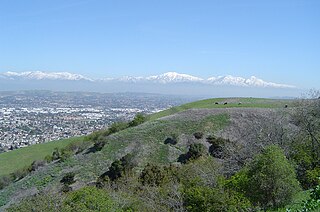
The San Gabriel Valley, often referred to by its initials as SGV, is one of the principal valleys of Southern California, with the city of Los Angeles directly bordering it to the west, and occupying the vast majority of the southeastern part of Los Angeles County. Surrounding landforms and other features include the following:
The San Gabriel Valley Tribune is a paid daily newspaper located in Monrovia, California, that serves the central and eastern San Gabriel Valley. It operated at the West Covina location from 1955 to 2015. The Tribune is a member of Southern California News Group, a division of Digital First Media. It is also part of the San Gabriel Valley Newspaper Group, along with the Pasadena Star-News and the Whittier Daily News.
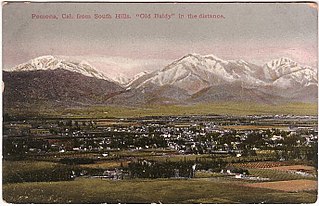
The Pomona Valley is located in the Greater Los Angeles Area between the San Gabriel Valley and San Bernardino Valley in Southern California. The valley is approximately 30 miles (48 km) east of downtown Los Angeles.
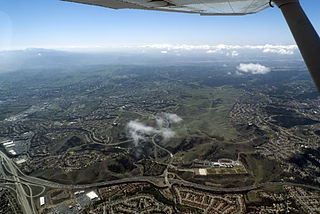
The Chino Hills are a mountain range on the border of Orange, Los Angeles, and San Bernardino counties, California, with a small portion in Riverside County. The Chino Hills State Park preserves open space and habitat in them.

The foothills of the San Gabriel Valley are the foothills and hills in the San Gabriel Valley of eastern Los Angeles County, California. They include the foothills of the San Gabriel Mountains, and independent low mountain ranges of hills, in the east Greater Los Angeles region. The landforms are part of the Transverse Ranges System of Southern California and Baja California.
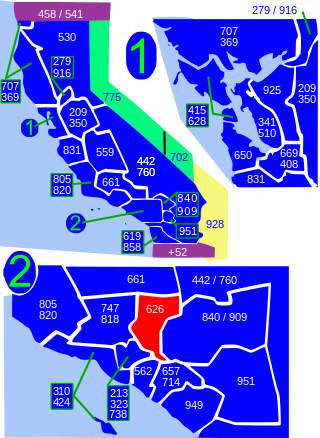
Area code 626 is a telephone area code in the North American Numbering Plan for most of the San Gabriel Valley in the U.S. state of California. The numbering plan area also comprises nearby areas in the northeastern portion of Los Angeles County, California, including Arcadia, Monrovia, El Monte, most of Pasadena and West Covina. The numbering plan area was split from that of area code 818 on June 14, 1997.

California's 38th congressional district is a congressional district in the U.S. state of California based in suburban eastern Los Angeles County and Orange County, California. The district is currently represented by Democrat Linda Sánchez.
Valley Boulevard is a street in Southern California, running east from Los Angeles to Pomona, where it becomes Holt Avenue, and a continuation from Fontana to Colton. It generally parallels Interstate 10 (I-10) and State Route 60 (CA 60), and is the original alignment of U.S. Route 60 (US 60). The present north end of I-710 is at Valley Boulevard in Los Angeles, just west of Alhambra.
California's 31st congressional district is a congressional district in Los Angeles County, in the U.S. state of California. The district is located in the San Gabriel Valley.
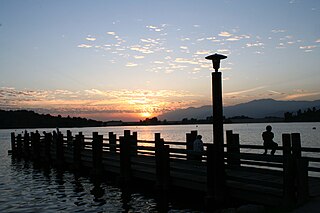
Puddingstone Reservoir is a 250-acre (1 km²) artificial lake northeast of the interchange between the Orange Freeway and the San Bernardino Freeway in Los Angeles County, California, United States. Activities include fishing, swimming, sailing, windsurfing, and camping. It is fed by Live Oak Wash and drains into Walnut Creek.
The Galster Wilderness Park Nature Center is a small museum and educational center set in Galster Wilderness Park, a 42-acre (170,000 m2) wilderness park located on the north slope of the San Jose Hills in the San Gabriel Valley, California. It is operated by the San Gabriel Mountains Regional Conservancy in partnership with the City of West Covina, California.
The Southern California Association of Governments (SCAG) is the Metropolitan Planning Organization (MPO) of six of the ten counties in Southern California, serving Imperial County, Los Angeles County, Orange County, Riverside County, San Bernardino County, and Ventura County. San Diego County's MPO is the San Diego Association of Governments, which is an unrelated agency.
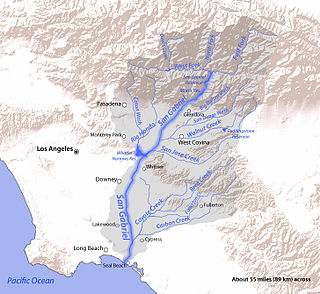
San Jose Creek is an intermittent, tributary stream of the San Gabriel River in Los Angeles County, California. The mouth of San Jose Creek is at an elevation of 194 feet at its confluence with the San Gabriel River, 3.5 miles (5.6 km) southwest of Bassett, California. Its source is at 960 feet near the Los Angeles County Fairplex, at 34°04′50″N117°45′38″W, where it has its confluence with Thompson Wash, actually a continuation of the creek into the San Gabriel Mountains. From Thompson Wash, San Jose Creek flows nearly 20 miles (32 km) westwards from Pomona into the San Gabriel River through the Pomona Valley and San Gabriel Valley. Because of its strategic location between the San Jose Hills and Puente Hills, the Union Pacific Railroad laid tracks along its route connecting Los Angeles with San Bernardino and Salt Lake City.

Walnut Creek is an urban stream in the San Gabriel Valley of Southern California, and is a tributary of the San Gabriel River. The creek begins at the Puddingstone Dam of Puddingstone Reservoir in Frank G. Bonelli Regional Park and flows westward for about 13 miles (21 km), through San Dimas, Covina, West Covina and Baldwin Park, to join the San Gabriel River in El Monte.

Walnut Islands or Ramona is an unincorporated area in the eastern part of Los Angeles County in the U.S. state of California. The former is the technical term used by the county government, while the latter was used by the Los Angeles Times in 2008 and the LA Metrolink. One news report referred to the area as Covina Hills. Walnut Islands is surrounded by the cities of Covina and San Dimas to the north, Walnut to the south, West Covina to the west, and Pomona to the east. The population of Ramona was 4,053 according to the 2000 census.















